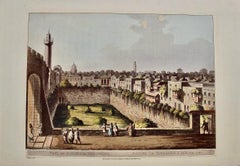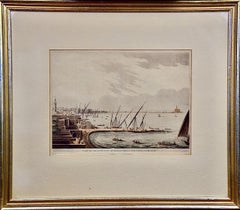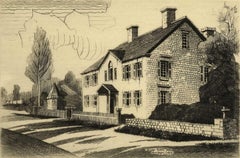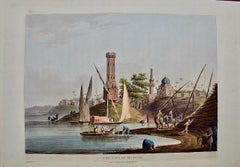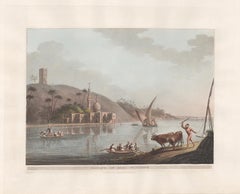Luigi Mayer Art
Italian, 1755-1803
Luigi Mayer (1755–1803) was an Italian-German artist and one of the earliest and most important late 18th-century European painters of the Ottoman Empire. Mayer was a close friend of Sir Robert Ainslie, 1st Baronet, a British ambassador to Turkey between 1776 and 1792, and the bulk of his paintings and drawings during this period were commissioned by Ainslie. He travelled extensively through the Ottoman Empire between 1776 and 1794, and became well known for his sketches and paintings of panoramic landscapes of ancient sites from the Balkans to the Greek Islands, Turkey and Egypt, particularly ancient monuments and the Nile. Many of the works were amassed in Ainslie's collection, which was later presented to the British Museum, providing a valuable insight into the Middle East of that period. His wife, Clara Barthold Mayer, worked as his assistant and produced her own paintings.to
1
2
Overall Width
to
Overall Height
to
3
2
1
3
1
1
1
1
1
3
3
3
3
9,440
2,689
1,374
1,362
1
2
3
Artist: Luigi Mayer
Pool of Bethesda, Jerusalem: A Hand-colored Aquatint & Engraving by L. Mayer
By Luigi Mayer
Located in Alamo, CA
This is a hand-colored aquatint and engraving entitled "Pool of Bethesda, Jerusalem", published in London by R. Bowyer in 1804. The print was created by Thomas Milton (1743-1827) from drawings by Luigi Mayer.
This beautiful, detailed, original engraving is printed on deluxe J. Whatman paper with very wide left and right margins. There is a watermark "1801" indicating the year the paper was made. The sheet measures 11.25" high and 16" wide. There is a small faint spot in the upper margin on the left and a tiny faint spot in the right upper corner and another in the left lower corner. The engraving is otherwise in excellent condition with vibrant colors throughout the image.
"The Pool of Bethesda...
Category
Early 19th Century Romantic Luigi Mayer Art
Materials
Engraving, Aquatint
Cairo with Murad Bey's Palace: A Hand-colored Aquatint & Engraving by L. Mayer
By Luigi Mayer
Located in Alamo, CA
This is a hand-colored aquatint and engraving entitled "Principal Square in Grand Cairo, with Murad Bey's Palace", published in London by R. Bowyer in 1801. The print was created by ...
Category
Early 19th Century Romantic Luigi Mayer Art
Materials
Engraving, Aquatint
Alexandria, Egypt & Lighthouse: A Hand-colored Aquatint & Engraving by L. Mayer
By Luigi Mayer
Located in Alamo, CA
This is a hand-colored aquatint and engraving entitled "Part of the New City of Alexandria, with the Light House", published in London by R. Bowyer from 1802-1805. The print was crea...
Category
Early 19th Century Romantic Luigi Mayer Art
Materials
Engraving, Aquatint
Related Items
Old Hoadley House
By John Taylor Arms
Located in New Orleans, LA
This image was in the personal collection of the artist. The Wheeler-Beecher House, sometimes referred to as the Hoadley House, is located on Amity Road in Bethany, CT. Built at the ...
Category
1910s American Modern Luigi Mayer Art
Materials
Etching
Original "Gone With The Wind" vintage movie poster 1980 excellent conditio
Located in Spokane, WA
Original GONE WITH THE WIND, U. S. 1 sheet Clark Gable, Vivien Leigh, de Havilland, all-time movie classic! Conservation linen backed and ready to frame. Original issue fold marks professionally touched up. Excellent condition.
Film Description: Gone With the Wind, the classic 1939 Victor Fleming Civil War romantic melodrama epic ("The Greatest Motion Picture Ever Made!"; "In the New Screen splendor… The most magnificent picture ever!"; "David O. Selznick's production of Margaret Mitchell's story of the Old South"; "Screen play by Sidney Howard") starring Clark Gable (in his nominated for Best Actor Academy Award role; "as Rhett Butler"), Vivien Leigh (in her Best Actress Academy Award winning role; "and presenting Vivien Leigh as Scarlett O'Hara"), Leslie Howard ("as Ashley Wilkes"), Olivia de Havilland (in her nominated for Best Supporting Actress Academy Award role; "as Melanie"), Hattie McDaniel ("as Mammy"), Thomas Mitchell ("as Gerald O'Hara"), Butterfly McQueen, Ann Rutherford ("as Carreen O'Hara"), George Reeves, Victor Jory, Jane Darwell, Ward Bond, Ona Munson ("as Belle Watling"), Yakima Canutt, Harry Davenport ("as Dr. Meade"), Carroll Nye ("as Frank Kennedy"), Laura Hope Crews ("as Aunt Pittypat"), Alicia...
Category
1980s American Modern Luigi Mayer Art
Materials
Offset
$600 Sale Price
20% Off
H 41 in W 27.25 in D 0.05 in
Original "Clear the Way!! Buy Bonds Fourth Liberty Loan, vintage poster, 1917
By Howard Chandler Christy
Located in Spokane, WA
Original "Clear the Way !!" Buy Bonds Fourth Liberty Loan vintage poster.. With Lady Liberty holding the U. S. Flag above the soldiers prepari...
Category
1910s American Realist Luigi Mayer Art
Materials
Lithograph
$1,200
H 30 in W 20 in D 0.05 in
Original Impermeaili Moretti Italian art deco vintage poster
By Leopoldo Metlicovitz
Located in Spokane, WA
Original Italian poster: Impermeabili Moretti by Leopoldo Meticovitz.
Archival linen-backed original Italian vintage poster IMPERMEABILI MORETTI. This pre-art deco poster is in v...
Category
1920s Art Deco Luigi Mayer Art
Materials
Lithograph
$2,650
H 54 in W 38 in D 0.05 in
The Helmsman
By Arthur John Trevor Briscoe
Located in Storrs, CT
The Helmsman. 1925. Etching. Hurst 130. 7 x 10 7/8 (sheet 11 x 5). Trial proof, apart from the edition of 75 An extremely rich impression printed cream wove paper. An exceptionally r...
Category
1920s Modern Luigi Mayer Art
Materials
Drypoint, Etching
Original "Niagara", Marilyn Monroe, 1953 vintage movie poster half-sheet
Located in Spokane, WA
Original “Niagra” vintage movie poster 22” x 28” half-sheet for Marilyn Monroe film. (1953) Profession acid-free paper backed for conservancy and entirely unrestored original U.S. 22” x 28” half-sheet poster, long considered the best layout for this title due to the horizontal art of Marilyn Monroe posing atop Niagara Falls. Very Fine.
Looking for Marilyn Monroe, Niagra original vintage movie poster for your home theater?
Are you looking for a gift for your husband? A vintage poster could be an excellent choice. We are selling this 1953 original vintage half-sheet movie poster with Marilyn Monroe in “Niagra”. Are you looking for a new wall decor to add some personality to your home? We have a huge collection of vintage posters...
Category
1950s American Modern Luigi Mayer Art
Materials
Offset
$1,480 Sale Price
20% Off
H 22 in W 28 in D 0.05 in
Original "1984 Olympics Los Angeles" Torch Runner signed and numbered
Located in Spokane, WA
The Los Angeles Olympics Torch /runner. 1984 Los Angeles Olympics original vintage poster.
Original, hand signed and numbered #232/300 "The Olympic Tor...
Category
1980s American Realist Luigi Mayer Art
Materials
Lithograph
$850
H 36 in W 22.75 in D 0.05 in
Harold Altman limited edition etching entitled "Park Path: Seated Bench Figures"
By Harold Altman
Located in Chesterfield, MI
Central Park, New York City is the locale for this subtle etching by Harold Altman.
It is yellowing a bit around the corners due to natural aging process, however the coloring of th...
Category
Mid-20th Century Abstract Expressionist Luigi Mayer Art
Materials
Etching
$320 Sale Price
20% Off
H 29 in W 22 in
Vote! Stop Fascism 20 Shepard Fairey / Ernesto Yerena Fine Art Urban Art Street
By Shepard Fairey
Located in Draper, UT
Edition Details
Year: 2020
Class: Art Print
Status: Official
Run: 67/450
Technique: Screen Print
Size: 18 X 24
Markings: Signed & Numbered
Category
2010s Street Art Luigi Mayer Art
Materials
Screen
Original Miss Robin Crusoe, 1953 vintage movie poster. half-sheet
Located in Spokane, WA
Original half sheet MISS ROBIN CRUSOE. With Amanda Blake, George Nader, Rosalind Hayes. As frenzied as voodoo Drums! As shocking as cannibal rituals! Very good condition, t...
Category
1950s American Realist Luigi Mayer Art
Materials
Offset
$119 Sale Price
20% Off
H 22 in W 28 in D 0.04 in
"In the Beginning There Were Mistakes" Gallery Poster
By Charles Bragg
Located in Chesterfield, MI
"In the Beginning There Were Mistakes" is a Gallery Poster featuring the artwork of CHARLES BRAGG (American, b. 1931). The print measures 28 x 22 inches and is unframed. It is Plate-...
Category
Late 20th Century Luigi Mayer Art
Materials
Lithograph
$128 Sale Price
20% Off
H 28 in W 22 in
Original 'Le Rapide Grande Journal Quotidien; art nouveau vintage poster
By Jules Chéret
Located in Spokane, WA
Original “Le Rapide, Grand Journal Quotidien” art nouveau vintage poster. Conservation linen backed and ready to frame. Year: 1892
Artist: Jules Cheret, referred to as the father of the poster.
Le Rapide, Grand Journal Quotidien. Jules Cheret (French, 1836-1932) is a well-listed draftsman, printmaker, and designer is best known as a fin de siecle poster designer. Arguably, he is the best-known French poster designer of his age.
Figure no 126; No 568; Posters of Jules Cheret.
Most people overlook the fact that she is still writing for Le Rapide using a quill instead of an ink pen. Yes, this poster is over 130 years old and still presents itself well. There are telegraph wires in the sky background. The last time this poster was sold in the big NYC poster...
Category
1890s Art Nouveau Luigi Mayer Art
Materials
Lithograph
$2,600 Sale Price
20% Off
H 48 in W 34 in D 0.05 in
Previously Available Items
The City of Menouf, Egypt: A Hand-colored Aquatint & Engraving by L. Mayer
By Luigi Mayer
Located in Alamo, CA
This is a hand-colored aquatint and engraving entitled "The City of Menouf", published in London by R. Bowyer from 1802. The print was created by Thomas Milton (1743-1827) from drawi...
Category
Early 19th Century Romantic Luigi Mayer Art
Materials
Engraving, Aquatint
H 11 in W 15.88 in D 1 in
Mosque of Abou-Mandour, Egypt, Luigi Mayer oriental colour aquatint engraving
By Luigi Mayer
Located in Melbourne, Victoria
From the series "Views in Egypt, Palestine and Other Parts of the Ottoman Empire" published between 1801 and 1804.
Sir Robert Ainslie, English ambassador in Istanbul from 1776 to 1792, employed the artist Luigi Mayer...
Category
Early 19th Century Naturalistic Luigi Mayer Art
Materials
Engraving, Aquatint
An Egyptian Fair at Kafr Radoin, Luigi Mayer oriental colour aquatint engraving
By Luigi Mayer
Located in Melbourne, Victoria
From the series "Views in Egypt, Palestine and Other Parts of the Ottoman Empire" published between 1801 and 1804.
Sir Robert Ainslie, English ambassador in Istanbul from 1776 to 1792, employed the artist Luigi Mayer...
Category
Early 19th Century Naturalistic Luigi Mayer Art
Materials
Engraving, Aquatint
A Hand Colored Engraving of an 18th-19th Century Egyptian Ruler by Luigi Mayer
By Luigi Mayer
Located in Alamo, CA
A hand colored aquatint engraving of "An Egyptian Bey" from "Views in Egypt, Palestine, and Other Parts of the Ottoman Empire", published in London by R. Bowyer from 1802-1805.The aquatints were created by Thomas Milton (1743-1827) from drawings by Luigi Mayer...
Category
Early 19th Century Romantic Luigi Mayer Art
Materials
Engraving, Aquatint
Luigi MayerA Hand Colored Engraving of an 18th-19th Century Egyptian Ruler by Luigi Mayer, 1802-1805
H 22.25 in W 17.5 in D 1 in
Luigi Mayer art for sale on 1stDibs.
Find a wide variety of authentic Luigi Mayer art available for sale on 1stDibs. You can also browse by medium to find art by Luigi Mayer in aquatint, etching and more. Not every interior allows for large Luigi Mayer art, so small editions measuring 18 inches across are available. Customers who are interested in this artist might also find the work of Eugene Corneau, Maxime Lalanne, and Angèle Delasalle. Luigi Mayer art prices can differ depending upon medium, time period and other attributes. On 1stDibs, the price for these items starts at $150 and tops out at $150, while the average work can sell for $150.
